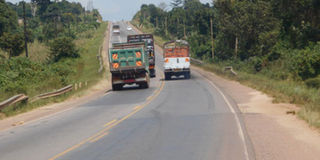Is the cause of accidents speed or skid?

A truck overtakes two trailers on Kampala-Masaka highway. Speeding is identified as one of the common cause of accidents on Uganda’s roads. FILE PHOTO
In the last few months, we as a nation have mourned the loss of loved ones and quite frankly looked on helplessly as the number of accidents increases steadily on the Kampala–Masaka highway.
Reasons for these accidents have ranged from a road too smooth to ghosts haunting the road users.
Many die as a consequence of driver inexperience, speeding, intoxication through drink or drugs or just plain recklessness.
Common factor
However, one thing is almost always mentioned in these accident reports is speed.
It is the one think that is the common denominator. The faster a car driver speeds, the less time you have to react, not to mention the increase in forces on the human body in a collision at high speeds.
As a result, personal injuries are worse in car accidents at high speeds. Naturally, many drivers in unusual road situations apply the brakes regardless.
Whether or not they could have avoided a crash, they simply slam the brakes. It is not an unnatural reaction.
Enter skidding. At high speeds, there is always a 100 per cent probability that you shall skid when you slam those brakes in case of an emergency.
This happens when one or more of your tyres are pushed beyond their ability to hang on to the road surface. When this bond is broken, you go from gripping to skidding, and it can happen fast.
While there are safety systems such as anti-lock braking system or anti-skid braking system (ABS) , on many cars today, the various other factors come into play including but not limited to the quality of your tyre treads. Skid marks are very common sights at car accident sites.
Element of the driver
Parallel to speed is reckless driving. Noteworthy is our driving tests do not measure driving skills and the knowledge of the driving rules sufficiently.
Driving schools take more care about parking, putting cars into reverse, doing U-turns, than about behaving on the road among dozens of cars.
The emphasis is laid on theory, not practice. It is said that 80 per cent of all accidents are caused by the driver.
The authorities are to start mandatory car checks for road worthiness. While this is a good start, the driver competencies are a much bigger issue.
Additionally, the penalties for, say, speeding are not punitive enough to be a deterrent.
How it happens
Back to skidding, there are two types of skid, ones affecting the front tyres and those affecting the rears.
When the front tyres skid, the car tends to go straight on towards whatever you are trying to avoid despite your efforts to convince it otherwise. In case of a corner, the car understeers to the outside.
When the rear tyres let go, the car rotates into the corner far more than you asked it to in terms of the steering angle. It oversteers.
Trust me, you will know the difference between understeer and oversteer when it happens.
Preventing a skid is a far better strategy than working to correct one.
In control at all times
The dominant forces at play are braking, acceleration and perhaps momentum. These will always win the arm wrestle at the expense of the grip required for stopping or cornering.
The skills of smooth driving, stopping and cornering technique should put you in good stead on that account, or simply drive slower.
Nonetheless, if you arrive at the point where the car is out of control, because of reaction time and human instinct, the odds just do not play in your favour.
Whatever the cause, when your car suddenly rotates more than you are expecting and skids sideways, it will scare the life out of you.
Only way I see is to simply drive slower, that way your reaction time is increased.
To note
The first thing to know is what are the common causes of a skid? You might encounter a slippery surface as many have cited with the Kampala-Masaka highway, but usually you create the skid by doing something that pushes the tyres beyond their limit such as braking too late and heavily, carry too much speed for a sudden stop or a corner, use rough or excessive steering, or accelerate too early or hard in the middle of the corner.




